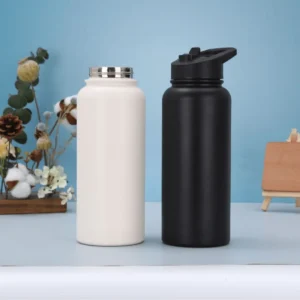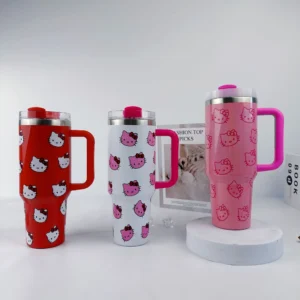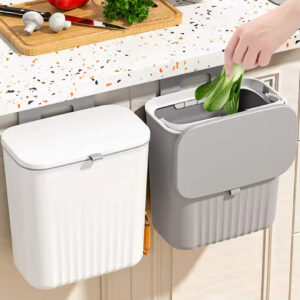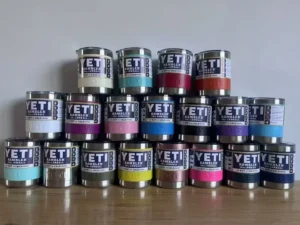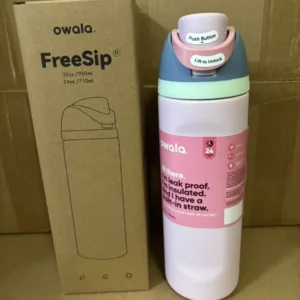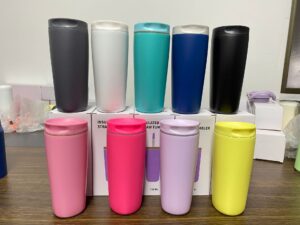
One-step gift customization and wholesale — customize any product you need with ease and efficiency!
Adakah Mesin Pencuci Pinggan Hidro Flask Selamat? Semua yang Anda Patut Tahu
Jika anda pernah terfikir adakah mesin basuh pinggan mangkuk Hydro Flask selamat, anda tidak bersendirian. sama ada anda pemberian secara pukal atau menggunakan satu setiap hari, adalah penting untuk memahami cara kaedah pembersihan mempengaruhi ketahanan, salutan dan prestasi botol. Dalam panduan ini, kami akan membahagikan bahagian yang selamat untuk mesin basuh pinggan mangkuk—dan cara membersihkannya dengan betul untuk memastikan Hydro Flask anda dalam keadaan terbaik.
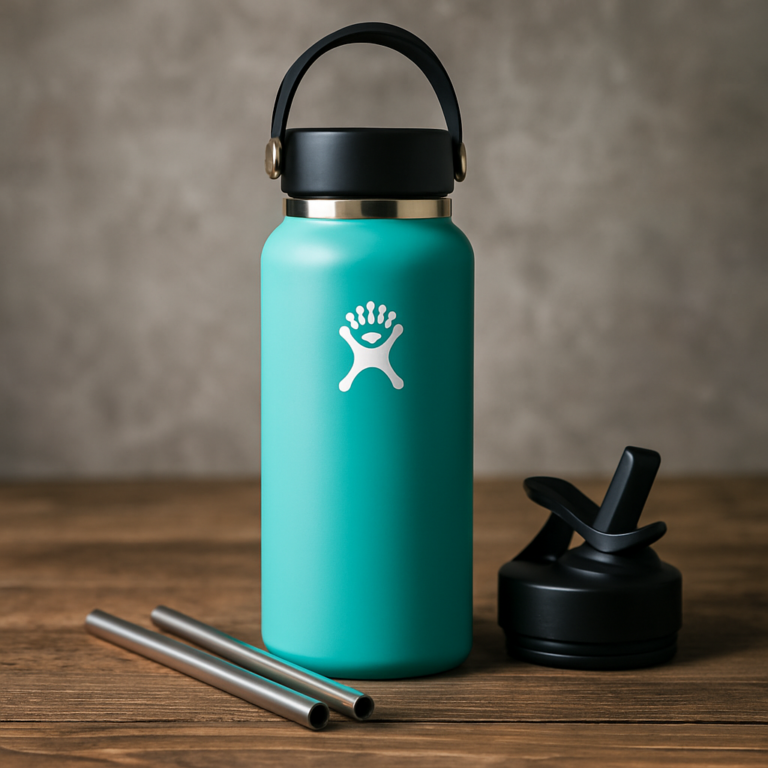
Hydro Flasks diperbuat daripada apa?
Untuk memahami sama ada Hydro Flask selamat untuk mesin basuh pinggan mangkuk, adalah berguna untuk mengetahui terlebih dahulu bahan itu diperbuat daripadanya. Hidro Flask biasa dibina dengan mengambil kira ketahanan, penebat dan keselamatan—berikut ialah pecahan bahan yang biasa digunakan:
1 . Keluli Tahan Karat 18/8
Ini adalah bahan utama yang digunakan untuk kedua-dua dinding dalam dan luar Hydro Flask. Ini bermakna keluli mengandungi kromium 18% dan nikel 8%, yang memberikan ketahanan yang kuat terhadap karat dan kakisan. Ia juga gred makanan, bermakna ia selamat untuk menyimpan minuman dan tidak akan mengekalkan perisa.
2 . Penebat Vakum
Di antara lapisan keluli dalam dan luar adalah ruang vakum. Penebat vakum inilah yang memastikan minuman sejuk selama 24+ jam atau panas selama 12+. Ia berfungsi dengan mengeluarkan udara antara dua dinding untuk menghapuskan pemindahan haba. Vakum itu sendiri bukan "bahan", tetapi ia adalah bahagian teras struktur botol.
3 . Salutan Serbuk
Permukaan luar yang berwarna-warni kebanyakan Hydro Flasks berasal daripada salutan serbuk tahan lama. Kemasan ini menambah cengkaman dan melindungi botol daripada calar dan cip. Walau bagaimanapun, ini juga merupakan faktor yang perlu dipertimbangkan semasa pembersihan—bahan pencuci yang menggunakan haba tinggi atau keras dalam mesin basuh pinggan mangkuk boleh merosakkan salutan ini dari semasa ke semasa.
4 . Komponen Tudung Plastik Bebas BPA
Tudung dan penutup biasanya diperbuat daripada polipropilena bebas BPA (plastik PP#5) atau bahan yang serupa. Sesetengah penutup termasuk gasket silikon untuk memastikan pengedap kalis bocor, dan penutup jerami selalunya mempunyai corong silikon lembut. Bahagian ini biasanya selamat untuk mesin basuh pinggan mangkuk rak atas, tetapi masih baik untuk menyemak semula model tertentu.
5 . Asas Silikon atau Aksesori
Sesetengah Hydro Flasks termasuk tapak silikon untuk mengelakkan tergelincir atau melindungi permukaan. Bahagian ini boleh ditanggalkan dan fleksibel, dan ia biasanya selamat untuk mesin basuh pinggan mangkuk atau mudah dicuci dengan tangan.
Adakah mesin basuh pinggan mangkuk Hydro Flask selamat?
Tidak semua bahagian Hydro Flask harus dimasukkan ke dalam mesin basuh pinggan mangkuk. Walaupun model yang lebih baharu secara teknikalnya selamat untuk mesin basuh pinggan mangkuk, adalah lebih baik untuk membersihkan beberapa komponen dengan tangan untuk memastikannya dalam keadaan terbaik. Begini cara setiap bahagian bertahan:
- Badan Botol:
Badan keluli tahan karat Hydro Flask secara teknikalnya selamat untuk dimasukkan ke dalam mesin basuh pinggan mangkuk, terutamanya untuk model yang dibuat selepas 2020. Walau bagaimanapun, Hydro Flask sendiri mengesyorkan mencuci botol dengan tangan untuk mengekalkan jangka hayatnya. Ini terutamanya untuk melindungi salutan serbuk luar, yang boleh pudar, mengelupas, atau tercalar oleh kitaran mesin basuh pinggan mangkuk yang berulang, terutamanya di bawah haba yang tinggi atau detergen yang keras. - Tudung Standard:
Kebanyakan penutup atas skru standard daripada Hydro Flask diperbuat daripada polipropilena bebas BPA (plastik #5), yang dianggap selamat untuk mesin basuh pinggan mangkuk rak atas. Untuk kemudahan, ini memudahkan pembersihan—tetapi sekali lagi, mencuci tangan akan memanjangkan ketahanannya, terutamanya untuk penutup dengan bahagian bergerak seperti bahagian atas flip atau mekanisme twist. - Tudung Jerami & Corong Silikon:
Tudung jerami dan penutup sukan termasuk bahagian tambahan seperti gasket silikon dan penyedut minuman. Ini biasanya selamat untuk mesin basuh pinggan mangkuk di rak atas, tetapi sisa makanan atau acuan boleh terkumpul di saluran sempit. Untuk mengelakkan ini, sebaiknya buka dan bersihkan tangan dengan berus sempit sekali-sekala, walaupun anda kerap menggunakan mesin basuh pinggan mangkuk. - Model Lama atau Botol Tersuai:
Jika anda mempunyai Hydro Flask yang lebih lama, atau yang dicetak tersuai (dengan logo atau pelekat), keselamatan mesin basuh pinggan mangkuk mungkin tidak terpakai. Model lama tidak direka bentuk dengan mengambil kira rintangan haba mesin basuh pinggan mangkuk, dan salutan tersuai mungkin tidak tahan.
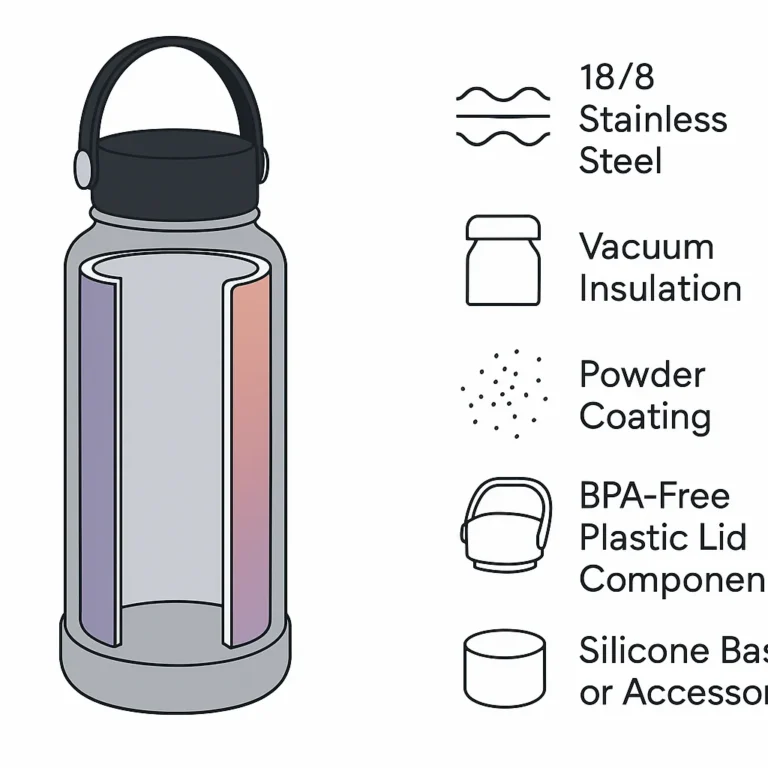
Bolehkah Hydro Flasks masuk ke dalam mesin basuh pinggan mangkuk?
Sama ada Hydro Flask boleh dimasukkan ke dalam mesin basuh pinggan mangkuk bergantung pada penjanaan, kemasan dan komponennya. Berikut ialah pandangan lebih dekat tentang perkara yang penting sebelum melemparkan botol anda ke dalam mesin basuh pinggan mangkuk:
- Model Hydro Flask yang lebih baharu: selamat untuk mesin basuh pinggan mangkuk
Jika Hydro Flask anda dibeli dalam beberapa tahun kebelakangan ini, ia berkemungkinan menampilkan lapisan serbuk Color Last™ jenama, yang direka khusus untuk menahan haba dan tekanan mesin basuh pinggan mangkuk. Botol ini biasanya dilabelkan sebagai "selamat untuk mesin basuh pinggan mangkuk" dan boleh diletakkan di atas rak tanpa kerosakan. Salutan serbuk tidak akan mengelupas, dan penebat kekal berkesan.
- Model lama: teruskan dengan berhati-hati
Model Hydro Flask yang terdahulu—terutamanya yang dibeli sebelum 2020—tidak mempunyai salutan keanjalan yang sama. Mencucinya di dalam mesin basuh pinggan mangkuk mungkin menyebabkan cat menjadi serpihan, pudar, atau malah pengedap vakum menjadi lemah dari semasa ke semasa. Jika botol anda tidak menyatakan keselamatan mesin basuh pinggan mangkuk, sebaiknya basuh dengan tangan menggunakan air suam dan sabun lembut.
- Periksa tanda selamat untuk mesin basuh pinggan mangkuk
Balikkan botol anda. Banyak Hydro Flasks baru-baru ini termasuk ikon selamat untuk mesin basuh pinggan mangkuk yang dicetak di bahagian bawah. Tiada ikon? Tetap dengan mencuci tangan. Anda juga patut menyemak sebarang arahan penjagaan yang disediakan bersama pembungkusan asal.
4. Jangan lupa tudung dan aksesori
Tidak semua bahagian botol adalah sama tahan lama. Walaupun badan keluli tahan karat mungkin bertolak ansur dengan kitaran mesin basuh pinggan mangkuk, penutup, penyedut minuman dan gasket silikon memerlukan pertimbangan yang berasingan. Ada yang selamat atas rak; yang lain mungkin meledingkan atau merosot jika terdedah kepada haba yang berpanjangan. Apabila ragu-ragu, basuh dengan tangan komponen yang lebih kecil.
Bagaimana untuk membersihkan Hydro Flask dengan betul?
Tidak semua orang mahu bergantung pada mesin basuh pinggan mangkuk—walaupun Hydro Flask mereka secara teknikalnya selamat untuk mesin basuh pinggan mangkuk. Mencuci tangan masih merupakan cara paling selamat dan berkesan untuk mengekalkan prestasi dan kemasan botol dari semasa ke semasa. Inilah cara untuk membersihkan Hydro Flask anda dengan cara yang betul:
1. Bilas dengan air suam selepas setiap penggunaan
Selepas penggunaan harian, terutamanya jika anda minum apa-apa selain air, bilas botol anda dengan air suam untuk mengelakkan pembentukan, bau atau pewarnaan. Langkah pantas ini membantu memastikan botol anda segar antara pembersihan yang lebih mendalam.
2. Gunakan sabun pinggan mangkuk yang lembut dan berus botol
Untuk pembersihan rutin, isi botol dengan air suam dan titisan sabun pinggan mangkuk. Gunakan berus botol yang dikendalikan panjang untuk menggosok dinding dalam dan bawah. Elakkan pad yang melelas, yang boleh mencalarkan bahagian dalam. Bilas dengan teliti untuk mengeluarkan semua sisa sabun.
3. Beri perhatian kepada penutup dan gasket
Tudung, penyedut minuman dan gasket silikon boleh memerangkap kelembapan dan menumbuhkan acuan jika tidak dibersihkan dengan kerap. Keluarkan gasket jika boleh, dan basuh semua bahagian secara berasingan menggunakan air sabun suam. Biarkan ia kering sepenuhnya sebelum dipasang semula.
4. Untuk pembersihan mendalam: gunakan baking soda dan cuka
Jika Hydro Flask anda mula berbau atau menghasilkan sisa degil, campurkan dua sudu baking soda dengan air suam dan biarkan ia meresap selama 15–30 minit. Untuk bau, anda boleh menambah percikan cuka putih. Selepas direndam, gosok dan bilas dengan baik.
5. Keringkan sepenuhnya dengan menutup penutupnya
Biarkan botol kering terbalik dengan penutupnya ditanggalkan. Kelembapan yang terperangkap di dalam botol tertutup boleh menyebabkan bau atau cendawan. Pastikan semua bahagian kering sepenuhnya sebelum menyimpan atau menggunakannya semula.
6. Elakkan meletakkannya dalam persekitaran yang melampau
Walaupun model anda dilabel sebagai selamat untuk mesin basuh pinggan mangkuk, kitaran haba tinggi berulang akhirnya boleh menjejaskan penebat atau salutan luar. Jika anda tidak pasti sama ada Hydro Flask anda selamat untuk mesin basuh pinggan mangkuk, basuh tangan kekal paling boleh dipercayai
Bagaimana untuk membersihkan penutup jerami Hydro Flask?
Tudung straw ialah salah satu bahagian yang paling banyak digunakan dalam Hydro Flask—dan juga yang paling mudah untuk memerangkap sisa, bau atau acuan jika tidak dibersihkan dengan betul. Berikut ialah cara untuk memastikan ia bersih dan berfungsi dari semasa ke semasa:
1. Buka penutup sepenuhnya
Keluarkan straw dari penutup. Jika penutup anda mempunyai gasket atau injap silikon, tarik keluarnya juga perlahan-lahan. Ini mendedahkan semua celah kecil di mana pembentukan boleh berlaku, terutamanya dari minuman manis atau air berperisa.
2. Basuh dengan air suam dan sabun
Gunakan span lembut atau berus kecil untuk menggosok tudung dan penyedut minuman di dalam dan luar. Berus straw (nipis dan panjang) sesuai untuk membersihkan di dalam tiub. Fokus pada kawasan corong—tempat sisa sering terkumpul.
3. Rendam untuk pembersihan yang mendalam
Jika penutup straw berbau atau tidak dibersihkan untuk seketika, rendam dalam campuran air suam dan baking soda selama 15–30 minit. Anda juga boleh menambah sedikit cuka putih untuk membantu memecahkan bakteria atau bau.
4. Bilas dan keringkan dengan udara
Selepas pembersihan, bilas semua bahagian dengan teliti dengan air bersih. Biarkan ia kering sepenuhnya sebelum meletakkannya semula. Memasang semula semasa masih lembap boleh menyebabkan acuan atau bau yang tidak menyenangkan.
5. Mesin basuh pinggan mangkuk? Mungkin—periksa model anda
Banyak penutup straw Hydro Flask secara teknikalnya selamat untuk mesin basuh pinggan mangkuk. Tetapi jika anda ingin memanjangkan hayat bahagian silikon dan mengelakkan meledingkan, mencuci tangan adalah pilihan yang lebih baik. Jika anda bertanya adalah selamat untuk mesin basuh pinggan mangkuk Hydro Flask, penutupnya biasanya—tetapi mencuci tangan dengan berhati-hati memberikan anda kawalan dan kebersihan yang lebih baik.
Jadi, adakah mesin basuh pinggan mangkuk Hydro Flask anda selamat?
Jawapan ringkasnya ialah—ya, jika ia adalah model yang lebih baharu dan digunakan dengan betul. Tetapi untuk prestasi jangka panjang, mencuci tangan sentiasa menjadi pertaruhan yang lebih selamat, terutamanya untuk penutup jerami dan kemasan bersalut serbuk.
Ingin menyimpan anda Kelalang Hidro dalam bentuk atas? Ikuti petua ini dan tandakan buku panduan ini.
pengenalan
Kami adalah sehenti hadiah tersuai syarikat, menawarkan reka bentuk, penyesuaian diperibadikan, pembungkusan yang elegan dan perkhidmatan penghantaran untuk membantu anda meningkatkan kehadiran jenama dan mengukuhkan hubungan pelanggan.
©2025. yourgiftstory Hak Cipta Terpelihara.


